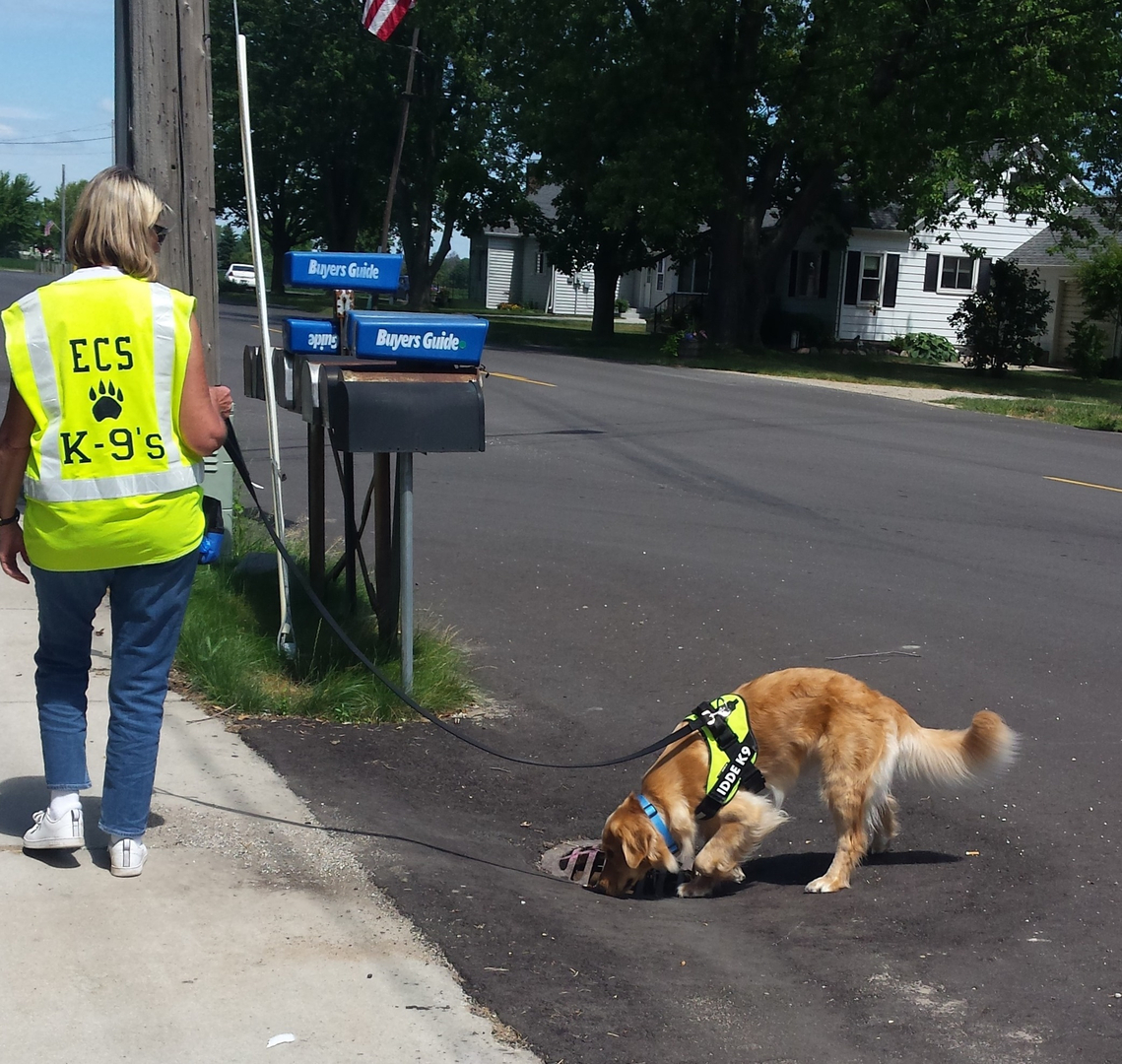
Handler Laura Symonds and Kenna, a 3-year-old golden retriever, search a manhole cover for evidence of human sewage at a manhole cover.
By Ben Muir
Karen Reynolds and her husband, Scott, used to train dogs to find drugs, bombs, people and poop.
Now they teach them to hunt for just the poop. Reynolds is the president of Environmental Canine Services LLC, a company that uses dogs to locate human waste.
The company has handler teams in California, Michigan and Maine. The geographical diversity is so that large dogs don’t have to fly in the cargo hold of a plane, and clients don’t have to pay for high travel expenses, Reynolds said.
“There is an exception,” she said. “One of our west coast canines is small enough to fly in the cabin of an airplane.”
Training a dog to find human sewage was a smooth transition, as the method is the same as training to find drugs or bombs, said Reynolds, who is based in Maine.
“‘I want you to find this scent and only this scent,’” Reynolds said. “The dogs’ sense of smell is huge. They can detect something that the source is miles away.”
When water experts find high levels of a bacterium that may sicken people, they often call on Kenna, a golden retriever that Reynolds trained for the job and that works out of Lansing, Michigan.
Kenna is a hyper and restless 3-year-old that relies on her sight and acute sense of smell to locate human sewage, said Laura Symonds, Kenna’s handler.
And it’s not just their nose that they use. Golden retrievers are rarely tuned into visual cues, but Kenna debunked that trend in the year it took to train her, Symonds said.
Kenna looks for manhole covers, which can lead to a cracked sewer pipe, one of the most common sources of E. coli.
“Kenna looks expectantly at me when she sees one, as if to say, ‘Can I go check that one, please?’” Symonds said.
Locating the sources of a bacterium called E. coli is how Michigan achieved a 7 percent decrease of reports of it in 2016, said Shannon Briggs, a toxicologist at Michigan’s Department of Environmental Quality water resource division.
Kenna will start at a creek that flows into a beach, sniffing upstream with Symonds close behind. When she sits down, she’s not resting. She is alerting that human sewage is there.
“It’s almost like playing the hot-cold game,” Briggs said. “If Kenna alerts, you’re in a hot stop.”
This continues until Kenna stops alerting, Briggs said. That tells Symonds that the E. coli source is between the first sit and the last.

Karen Reynolds is the president of Environmental Canine Services LLC, a company that uses dogs to locate human waste.
To confirm that Kenna is right, water quality experts use a second testing method called Quantitative Polymerase Chain Reaction or QPCR. It analyzes DNA in bacteria, indicating if the E. coli comes from a human cow, pig, or bird, Briggs said.
There are E. coli cases in Michigan where a flock of seagulls will sit on a beach parking lot, pooping all day. Rain will slide that waste onto the beach and into the lake. Other instances include geese that like large fields to rest on. Rainwater will transport the goose waste into nearby streams.
“If I am going to collect a water sample and have it tested with the QPCR method, I need to know where the source is. I need to know what I’m looking at,” Briggs said. “That’s why I like using the dogs and QPCR together.”
Another common source of human E. coli is septic tanks. An overflowed septic tank can cause human waste to seep into a tile field, which also flows to fresh water. In Michigan, septic tanks are a statewide problem, Reynolds said.
“It’s hard to get people to pay attention to what’s underground,” Reynolds said. “A lot of them are getting old.”
Which makes the canine resource so important, Briggs said.
She’s not surprised that the four-legged animals have expedited the search for E. coli in Michigan.
“When a dog smells, they smell everything,” Briggs said. “When humans smell beef stew, we smell beef stew, that’s it. But a dog can smell the beef, carrots, celery and potatoes.”
